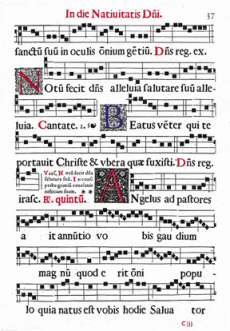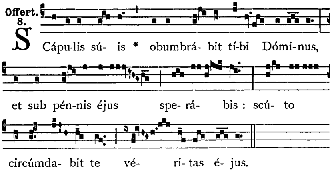

|
|
| Musical Musings: Miscellaneous |
Gloria in Excelsis Deo!Why is Gregorian chant making a comeback?This article is reprinted here with the kind permission of the authors, Arlene Oost-Zinner and Jeffrey Tucker, and of York Young, Managing Editor at The Catholic Answer, where it first appeared in the November/December 2007 edition.
The Pope has been quite direct in other settings as well. "An authentic updating of sacred music," he said in June 2006, "can take place only in the lineage of the great tradition of the past, of Gregorian chant and sacred polyphony." (Polyphony is music performed by multiple voices singing different, harmonized parts.) Last but not least, Pope Benedict's recent apostolic letter Summorum pontificum (July 7, 2007), which allows for a wider celebration of the traditional Latin Mass, now sets the stage for a wider use of Gregorian chant as well, given its important role in that form of the rite. This is a Vatican-wide initiative, with an emphasis on the English-speaking world, where the neglect of the treasury of sacred music is widespread and well-known. Cardinal Frances Arinze, head of the Vatican congregation that oversees the sacred liturgy, spoke in Saint Louis last year and urged a remedy. He said that in the average parish, Gregorian chant should be constantly present. These statements echo authoritative documents of the Church: Gregorian chant, says the General Instruction on the Rman Missal [GIRM], holds "pride of place because it is proper to the Roman liturgy." This in turn restates the message of the Second Vatican Council, whose Constitution on the Sacred Liturgy, Sacrosanctum concilium (1963), teaches that chant represents the ideal liturgical music, the standard against which all else should be measured (see Nos. 116-117). Clearly, then, the council fathers never intended for chant to vanish after Vatican II. Quite the opposite. Pope Paul VI, in 1974, issued a book of chants along with the pastoral letter Voluntati obsequens. "Those who are trying to improve the quality of congregational singing," said the letter, "cannot refuse to Gregorian chant the place which is due to it." Again, we find the same emphasis from Pope John Paul II, whose Chirograph on the Centenary of Pius X's Moto Proprio on Sacred Music (2003) insists, "Among the musical expressions that correspond best with the qualities demanded by the notion of sacred music, espe-cially liturgical music, Gregorian chant has a special place." He adds that the chant is an element of unity in the Roman liturgy. What Is Gregorian Chant?The Gregorian tradition took shape in the eighth century as the primary song of the Latin rite. It fused Gallican, Frankish, Jewish and Roman styles, growing up alongside the Mass. Popes have consistently emphasized that it should be studied, perfected and used, not just in religious communities and cathedrals but in all parishes. That is in part because chant embodies the pace, rhythm and transcendent longings we find in Scripture, particularly the Psalms. The tradition of Gregorian chant in the Latin rite provides music that meets the needs of all ages, classes and ethnic groups, not just in our times but in all times. The chant is intimately linked with Catholic faith and its prayer life. It takes us out of our everyday environment to remind us that we are in a sacred space. It helps us pray. For all these reasons, chant has begun to move beyond the world of CDs and movie soundtracks, entering once again into our parish lives. The National Registry of Gregorian Scholas (choirs), for example, lists more than 100 groups singing in parishes around the country. But more needs to be done. Because the music is so different from popular styles, it can be a challenge to sing. The sheer quantity of Gregorian chant is overwhelming; even in several lifetimes, it would be impossible to learn it all. But there is a core that can be broken down into three parts.
Chant Means Change
Everyone knows about the feuds over liturgical music. Chant offers a peaceful "third way." It can have an appeal to all parishioners, provided it is presented properly. Chant links all generations now living and binds us to Catholics in all times and places. It exists not as a time-bound statement about musical fashion, but rather as a timeless melodic means of community prayer. Chant encourages reverence, prayer and an awareness of the transcendent purpose of liturgical action. Chant catechizes and serves an evangelistic purpose. Yes, introducing chant means change. Progress in learning it must be counted in years, not weeks or months. But once the ground is prepared, the quiet solemnity of chant can take root and grow, persuading people of its merit by the hearing and doing. Singing it is more convincing than arguing about it. A Call for HumilityThe renewed emphasis on chant in liturgy is a call for humility above all else. Musicians are being asked to serve rather than perform. The motivation must be love of liturgy and its source, love of sung prayer and its purpose, and a genuine desire to hear the people of God united in one voice in praise and thanksgiving. Rome has been thoroughly consistent on the matter of liturgical music and the importance of using Gregorian chant in worship. But genuine change in response to these directives must begin in the parish community. It must come from the people and their pastors so that it can truly take root once again in the life of everyday Catholics. Copyright © 2007 by Our Sunday Visitor Publishing. All rights reserved.
See also:
|
 The pontificate of Pope Benedict XVI has been marked by new efforts to promote excellence in sacred music.
His apostolic exhortation of March 2007,
The pontificate of Pope Benedict XVI has been marked by new efforts to promote excellence in sacred music.
His apostolic exhortation of March 2007,  Many pastors who lack experience with the chant worry about pushing something new on their congregations or music directors.
And yet this is not just any change: It's a movement toward fulfilling the wishes of the Church.
Just as we expect certain types of music at the baseball game or a restaurant, there's a type of music particularly suited for Mass.
Many pastors who lack experience with the chant worry about pushing something new on their congregations or music directors.
And yet this is not just any change: It's a movement toward fulfilling the wishes of the Church.
Just as we expect certain types of music at the baseball game or a restaurant, there's a type of music particularly suited for Mass.